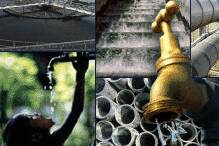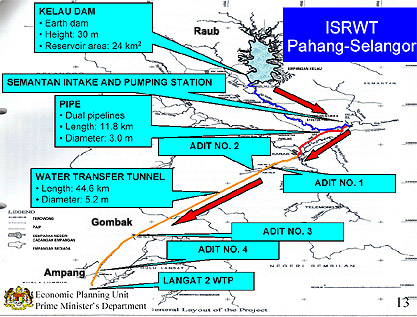The government should focus on managing demand instead of increasing water supply, said a coalition opposed to destructive river development today.
Objecting the plans to build the Kelau Dam in Pahang ( see map below ), Save Our Sungai Selangor (SOS Selangor) said the strategy of increasing supply to match growing consumption is unsustainable.
In a statement, it said the Environmental Impact Assessment (EIA) report issued for the project stated that water demand in the Klang Valley increases by seven percent annually.
 This would mean doubling water supply every 10 years - from the current 2,500 million litres per day (mld) to 5,000 mld in 2017, 10,000 mld in 2027, and 20,000 in 2037.
This would mean doubling water supply every 10 years - from the current 2,500 million litres per day (mld) to 5,000 mld in 2017, 10,000 mld in 2027, and 20,000 in 2037.
"Is this a viable rationale?" asked SOS Selangor, noting that Klang Valley per capita water consumption was among the highest in the world at 559 litres per day (lpd).
Singapore consumes 320 lpd per capita, Bangkok 370 lpd, and Sydney a mere 214 lpd.
The Kelau Dam is part of a larger inter-state raw water transfer plan conceived during the tenure of former premier Dr Mahathir Mohamad to head off the water crisis expected to hit Kuala Lumpur, Selangor and Putrajaya in 2010.
Costing RM3.8 billion, the project will divert water from Pahang to Selangor through a 44 km tunnel that cuts through the Main Range. It will also involve the clearing of 1,549 hectares of the Lakum Forest Reserve.
Hundreds of Temuan Orang Asli of Sungai Temir and Malay farmers and residents will have to relocate to make way for the project.
SOS Selangor said the environmental and societal impact of the dam far outweigh the temporary reprieve granted by the diversion of water from Pahang's Sungai Telemong.
'No other way'
A more viable strategy, the coalition added, is demand management, which includes taking steps as:
- installing new efficient toilet flush with dual flush for small or big flush;
- regulation for new housing projects making compulsory the installation of new flush systems, and subsidies provided to encourage replacement of old flushes;
- rain water collection systems for watering the garden and washing cars;
- public education on critical water supply situation and the need to reduce consumption and wastage;
- mending old leaky pipes, which contribute to16% of the 40% non-revenue water.
Environmental experts have predicted that the flooding that will occur over 16 percent of the forest will not only lead to the loss of 88 species of plant and animal life, but also threaten endangered species that live in the reserve.
It is believed that the government will decide soon whether to embark on the inter-state water transfer or not. The Ninth Malaysia Plan states that the water transfer project is to begin either this year or the next.
Last week, Natural Resources and Environment Minister Azmi Khalid said "there is no doubt that the flora and fauna in the forest reserve will be affected but there is no other way ."


